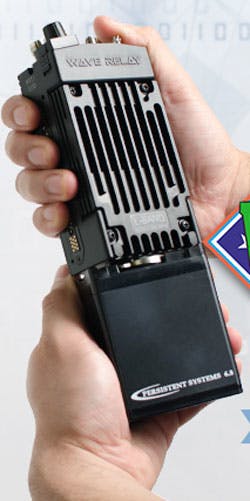MPU5 mobile ad hoc networking (MANET) radios are widely used in government and private sectors for their flexibility and portability. But they may not have been considered the most secure portable radio options until recently, when Persistent Systems, LLC revealed that they had received a Level 2 Federal Information Processing Standards (FIPS) 140-2 security validation from the National Institute of Standards and Technology (NIST).
The validation is an indication that the networking radio meets the government’s strict requirements for cryptographic data security. As such, it can provide greater service to users in a wide range of applications, including for defense, government, public safety, healthcare, and other industries.
The compact, portable MPU5 radio (see figure) provides secure wireless communications of voice, video, and data over controlled distances. “The MPU5 runs the Wave Relay MANET routing protocol, allowing users to transmit and relay voice, video, text, and sensor data in a true peer-to-peer fashion,” said Eric Stern, director of engineering at Persistent Systems. “This makes it a very attractive option for a wide variety of users, from the military to law enforcement, to the federal government and the healthcare industry.”
Courtesy of Persistent Systems, LLC
The radio received a Level 1 FIPS 140-2 validation in May of this year. The FIPS 140-2 Level 2 validation incorporates the Level 1 cryptographic data security requirement with the additional requirement of physical security mechanisms, such as tamper-evidence, allowing the MPU5 radio to be used for more sensitive data-transmission applications.
“FIPS 140-2 Level 2 provides further confirmation that our MPU5 is not only the most advanced and most scalable MANET radio, but it is also extremely secure,” said Stern. Persistent Systems has a long history of developing and supplying reliable, high-performance portable radios, including MPU3 and MPU4 radios which were FIPS 140-2 Level 2 validated.
About the Author
Jack Browne
Technical Contributor
Jack Browne, Technical Contributor, has worked in technical publishing for over 30 years. He managed the content and production of three technical journals while at the American Institute of Physics, including Medical Physics and the Journal of Vacuum Science & Technology. He has been a Publisher and Editor for Penton Media, started the firm’s Wireless Symposium & Exhibition trade show in 1993, and currently serves as Technical Contributor for that company's Microwaves & RF magazine. Browne, who holds a BS in Mathematics from City College of New York and BA degrees in English and Philosophy from Fordham University, is a member of the IEEE.


